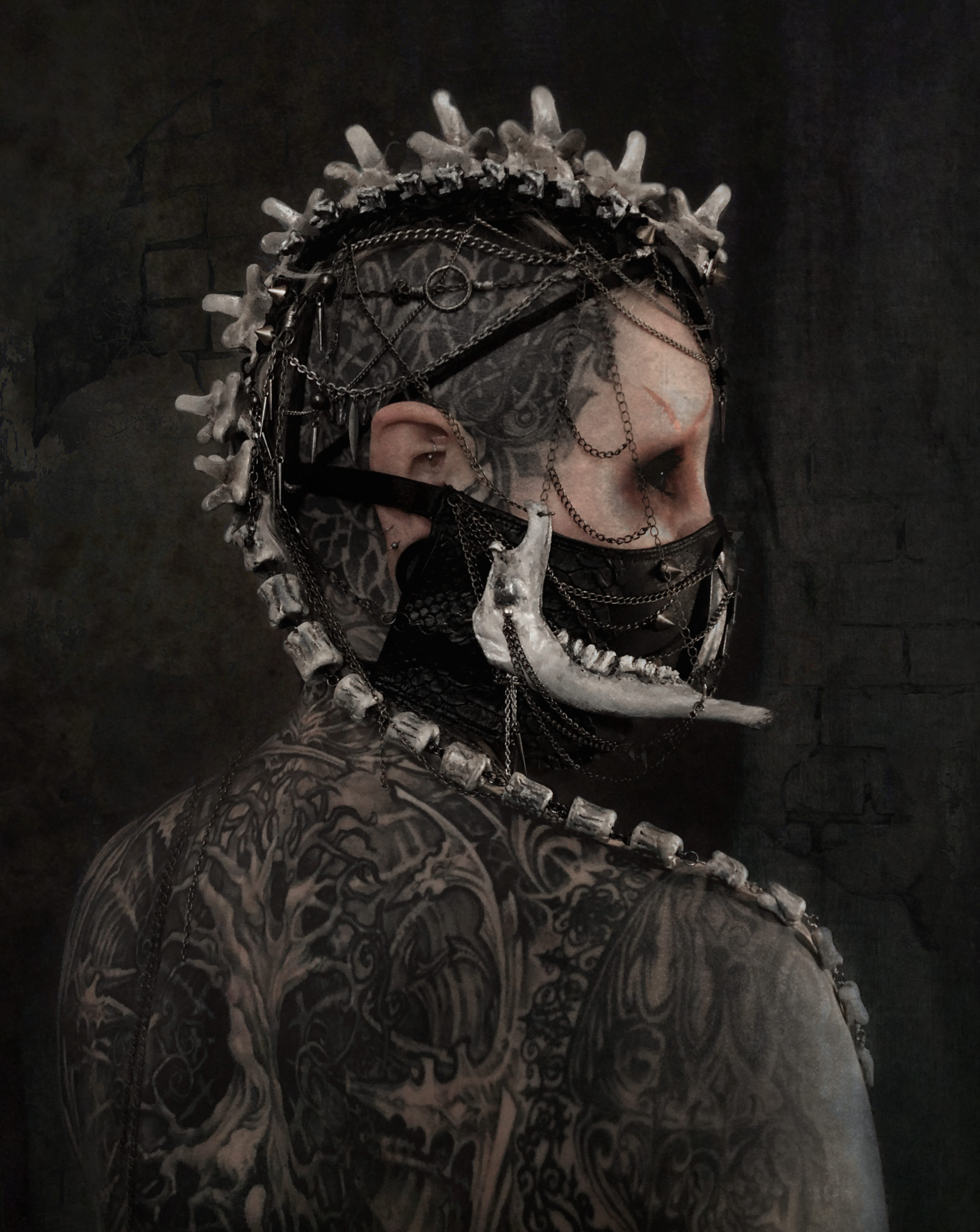
Light slowly rises on a lone hooded figure standing in front of a cauldron on a stage. Through a series of precisely executed gestural sigils, the witch weaves a spell over the mesmerized audience. As the dark energy builds, the witch sheds human form and is revealed as the glorious and fearsome deity Baphomet holding dominion over all who look upon it.
It is energetically-shifting magic tricks like this metamorphosis undertaken in the dance performance The VVitch that Raven Ebner AKA Corviid seems to effortlessly pull off in their work. Performed at Raven’s Night in Alexandria, Virginia a few months before anyone had heard of Covid-19, Corviid’s powerful choreography in The VVitch piece is a beacon for searching souls.
With any opportunity to perform in public spaces halted due to social distancing, Corviid is turning to other forms of expression. While Corviid’s labours have always taken on a variety of forms ranging from fusion dance performances, costumery, fine art painting, illustration, jewelry making and prop fabrication, the unifying themes are ritual and transformation.
Inspired by mythology, folklore and the occult, Corviid’s work explores manifesting the energy shifts we want and need as well as making the best of the transformations thrust upon us.
In this period of rising dark energy that is threatening to consume us and growing calls for change, I contacted Corviid to get perspective on the role of artistic expression and ritual when the world is in flux.
You are a creative multidisciplinary artist living in San Francisco, California. How has your daily life changed since the spread of Covid-19?
Before anyone had even heard of the virus, at the end of 2019, I had already completely uprooted my life, so this personal state of chaos and change has simply converged with that very state on a global scale.
It began with a rapid-fire series of endings in my life. My day-job ended; it was a year-long fabrication & conceptual design project, and before that I had been an independent artist for over a decade. The job had been the first stable, well-paid art gig in my entire life.
The same month, I lost my apartment in Oakland. So, I floated in the area for a few months staying with friends, then packed up my car and started driving across the country. I had a plan to be nomadic for the next year at least, and I had some performances booked along my travels.
At the end of the drive I planned to stay with my partner in North Carolina for a bit to take a break and recover from some massive burnout. I was going to rest, then start working on just my own art for the first time in years before traveling up the east coast, then back across the country to travel the west coast where I was going to vend art, jewelry, and costuming while couch-surfing and living out of my car.
So, all this change had already happened, and as I landed in NC I started a sort of self-imposed isolation. Since shelter-in-place happened, it essentially prolonged this period of hibernation for me.
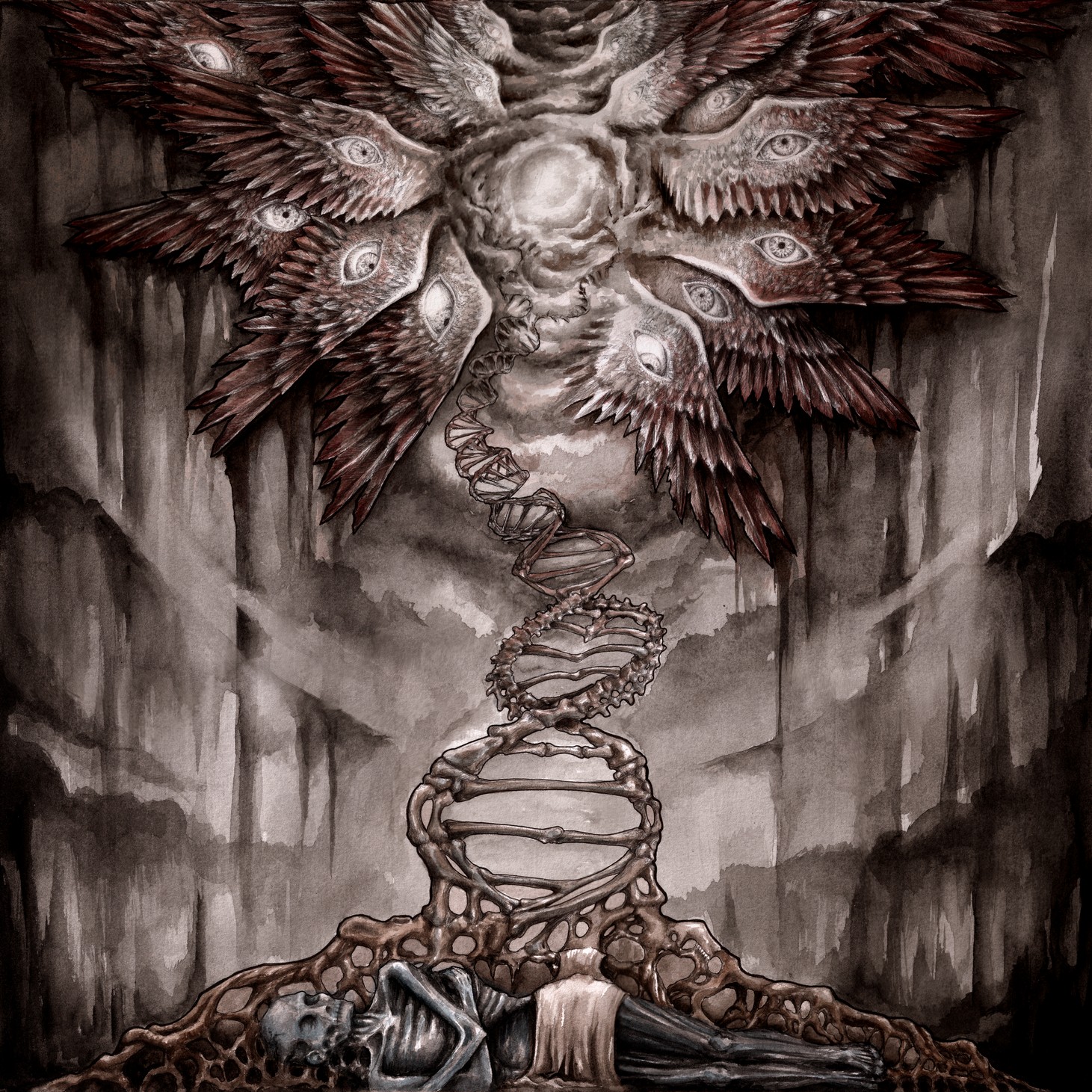
Has your creative process been affected during this time? Are you making art? If you are making art, what have you been working on?
My creative process has been impacted by the emotional landscape that’s been painted by events in the world and the effects of a self-imposed isolation suddenly becoming externally enforced and protracted beyond my original plans.
I already deal with depression and chronic fatigue/illness, and so while this situation exacerbates those greatly, it is a struggle that I am used to and have the tools for. But that is to say that I do have to work twice as hard to find my motivation and focus during all of this.
However, I am pushing through to create.
After a few years of focus on fabrication work, and on dance performance, I longed to get back to painting and illustration. I’ve done several smaller paintings and illustrations to practice technique and to find my love of the process again. I’m working on a large personal painting.
For personal works – on the rare occasion I make time for them – I have a habit of using dark surrealism to portray a revelatory or emotional experience of mine through visceral imagery, often balanced out with ornamental motifs. On this painting I’ll also be taking a go at hand-sculpting the frame to create 3-D/bas relief elements that complement the 2-D painting.
I took a pause to create a headdress & mask for an upcoming (online) headgear show for a shop in San Francisco. I leaned into my apocalyptic aesthetic for this one to create a set I call “Warrior of the Wastes” [see photo at the top of this post] because it feels good to inject some defiance into it (and not the kind of defiance where you refuse to wear a mask.. that’s just selfishness). I felt like I couldn’t let this period of time go by without making at least one mask.
As a prolific creative, do you have a goal or vision for the work you put out into the world? Do you find that shifting at all during this time?
A long time ago when I was first getting started as a full-time artist, I found myself stymied by the pressure I put upon myself with what I created. So, I made an agreement: my work didn’t have to be beautiful or ground-breaking or amazing. it just had to be honest and authentic. I figured if I allowed myself that, then I could actually go forward with creating, and the technique and ability would follow, because as we know, you have to create a lot of terrible things to make something good.
I also consider making art a process of expanding the connection between the conscious mind and the subconsciousness. So a lot of what I put into my vision is drawing from my subconscious mind and my shadow self. Not only do a lot of our personal truths lie there, but if there is any connection to the rest of the world (a collective unconscious), any dissolution of the self while we are still alive, it’s going to be housed there as well.
So, my goal with my art is to pull this shadow into the light, and when putting it out in the world, what I hope is that it speaks to other people in a similar way.
Right now I feel called to address what the world is going through, though I’ve never really done straight-forward commentary or political art and that’s not going to shift now. The challenge is to figure out how to turn my particular lens on all of this, and which of my personal archetypes can speak to this, because to do otherwise would feel disingenuous.
Long before this I started contemplating the idea of apocalypse and how the meaning of it has changed in different historical contexts. Its original meaning is an unveiling of truth. It has transformed to mean a collapse in civilization, and for a while I wanted to do a piece that explored that dichotomy.
Well, now we’re having a sort of apocalypse, where cataclysmic societal change is happening, AND it is unveiling the truth in so many ways: from bringing inequities and hypocrisies of our government to the surface for all to see, to showing people’s real nature during crisis (for better and for worse). So, some of my next pieces are probably going to explore this, but I haven’t quite figured out what that will look like yet.
Overall I’m trying to remember that gestation takes time, and so there is not an urgent obligation to speak to the state of the world right away. Some of us need to just sit with what’s going on for a while, and perhaps focus on surviving it intact before we can become mouthpieces for it.
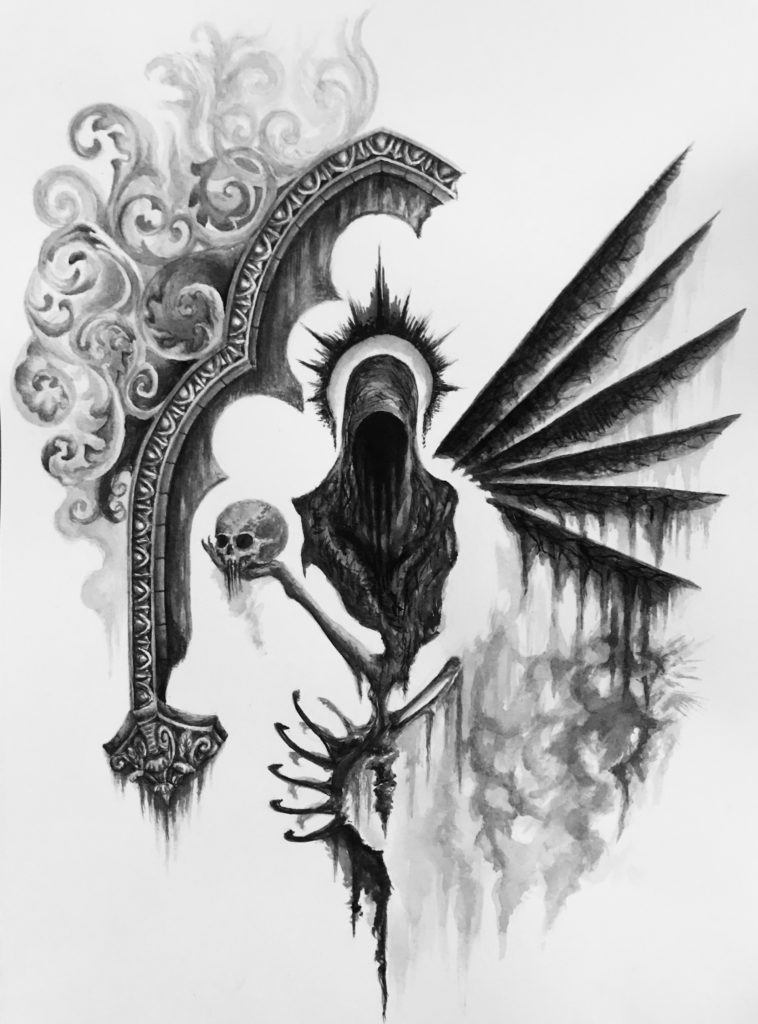
A great deal of your work, from the painting Who Came Before to dance pieces such as Anatomy of Decay and Memento Mori, explores symbols of mortality. Do you feel more or less compelled to explore mortality in your creative work at a time when so many are aware of a heightened fear of death?
I feel at least as compelled to explore mortality now. One of the reasons I explore it in my art to begin with is because I am trying to find my own healthy relationship with death in a society that has a toxic, avoidant relationship with it. And since we experience many metaphorical deaths during the course of our life, this denial of bodily death seeps into those, and we become resistant to change because each change is a death and a painful rebirth.
We are being forced to confront death in a brutal, tragic way. But hopefully in reckoning with our relationship to death, we also become more able to adapt to and enact change. It’s more important than ever to face the idea of death and impermanence, so I fully intend to do so in my art, though what that looks like may change symbolically because of all of this.
Aside from mortality, the other prevalent theme in your creative pursuits is magic and ritual. In what ways have you been engaging in sigil creation and personal ritual during this time period?
There are different levels of ritual/magic I engage in, and to understand these, it’s important to describe how I personally conceive of magic as a force in our reality. I approach it with a scientific, skeptical lens, though I also embrace the unknown mystery of it.
Just like in creating an art piece, magic and ritual are methods of connecting to the subconscious. The first goal is to explore and know the inner world, and only then can change in the outside world be enacted.
This may seem reductive, and like it makes magic isomorphic with cognitive science or psychology, but I believe that our inner worlds are so complex that plenty of mystery still remains.
Things seem magical when you’ve lost track of the causal chain between impetus and result, and therefore some end emerges mysteriously from an initial act. But to understand that the causal chain is still there, even if we cannot trace every step, is to understand the form and function of ritual without needing to break it down to a materialist level.
Additionally, my personal art IS one of the main forms that magic and ritual take for me… so in that way my art is occult and my process sacred.
I had abandoned that particular form of the practice for years out of mundane necessity; I had to prioritize commissions in order to earn a living, so returning to my personal practice is an important way in which I’m reconnecting to my practice of magic, and it couldn’t be a more important time to do that.
These personal paintings, for me, are often sigils. My sigil creation often takes the form of what we typically think of as sigils: more simplistic collections of lines, drawn from familiar words or objects and morphed until they bypass conscious recognition and speak directly to the subconscious.
But sigils can look more complicated than that, because my definition for them is purpose-based. So according to this definition of the function and process of sigils, my personal work fits this mold.
I think of those more as meta-sigils (not too dissimilar from Grant Morrison’s idea of the Hypersigil). Often, I even blend the two methods, as I have also blended sigils with performed rituals (whether it’s distilling the ephemera of movement into a solid sigil, or creating an ephemeral sigil with the movement). I believe in the power and efficacy of mixed-media work, in both art and occult.

Does the role of ritual change or take on a different level of importance during a time of universal trauma? Or is ritual for you mainly about personal transformation and unconnected to current events?
I’d say that the role of ritual as personal transformation and its connection to universal situations are not mutually exclusive; indeed they might be inseparable. So, with extreme external changes, the role and the lens for the ritual changes as well.
For one, it changes on an intuitive level, simply because as artists we’re often connecting more strongly to that collective unconscious and are influenced by what’s roiling around in there. However, there is also the call to respond to all of this, and like any level-headed, aware person right now, I’m angry and sorrowful at the state of the world – that which is brought on by the virus and that simply exposed and/or exaggerated by it.
It can be easy to get too weighed down with everything and get mired in despair. So, ritual also changes to become something that allows me to take care of myself and transform through all of this in a way that is positive so that I can go forth and address the universal trauma and enact change outside of myself as well.
You studied ecology and evolutionary biology in college. And many of your paintings incorporate natural elements like skeletons and veins. Have you drawn any inspiration from the virus as a scientific phenomenon to funnel into your work?
I haven’t, though that’s not to say that I won’t. I don’t think I see myself drawing on the actual microscopic form of the virus.. I tend to be less literal than that. I may explore its implications on an ecological level; I’m certainly already looking at its social and cultural effects for some future works.

Some of your creative work, namely painting, illustration, and costumery are more solitary pursuits. While your other work as a choreographer and dance troupe director is largely performative and relies on both collaborating with other artists and an audience. Are you feeling out of balance now that there are no public performances happening?
I had already started a shift toward solitude, mainly just because of the way my life had changed late last year.
I tend to go through phases of solitude versus collaboration, just as I phase through different medium focuses depending on opportunity and personal drive. I had decided to take a break from most dance performances and especially collaborative work.
I think when I start up dancing again, I’m going to do what I’m doing with my visual work, namely focus more on personally meaningful pieces (which may include responding to the state of the world).
Oddly enough, the last performance I did (it was in February right before things shut down), which was a group piece, was about bringing the end of the world, and I played the part of Pestilence. Additionally it was a pretty dark time for me, so it feels like what was going on personally was mirroring the darkness in the world.
When I do start back up with dance again, I think I want to defy all of that and make the experience the opposite. Make a piece about renewal and healing. I mean, it’ll still look pretty dark from the outside, but dance was always about letting my demons out so I could transform them.
Is there any benefit to pausing the performative aspect of your life? Do you get to focus more on other artforms and/or take some time to find new inspiration? Or is it throwing everything off for you?
There certainly is a benefit; I had already planned on doing this because I did need a break. I am very happy to be focusing on my visual art again, and I think my dancing will benefit greatly from getting a rest. Dance and visual art have always fed into and inspired each other, and I think too much time away from one of those can actually starve the other.
Before social distancing was in place, what did you find compelling about performing?
I’ve been exploring the intersection between art, ritual and performance for a long time, both on my own and with various groups.
Doing ritual suspension was one of the ways in which I was originally inspired to delve into and contemplate how these things serve each other, if done carefully and mindfully. I began to extend that into my dance.
Each one has different portions of those elements… suspension was always heavier on the ritual, and my choreographed dance works were heavier on the art, but often included elements of ritual too.
Performance is a delicate dance with the ego, and ritual requires some form of transforming the ego, usually with a sense of letting it go or diminishing it. So the two coming together creates this really unique tension. I find it to be a compelling challenge.
In addition, performing gives you a chance to bring others on your journey with you, and is a real test of one’s efficacy as a storyteller. Any performer will tell you there is a synergy that happens with the audience; a feedback loop that increases the intensity of the performance. Those moments that happen on stage are a single, ephemeral bit of power that will never exist again, anywhere else (even/especially in video of those moments… that’s why video never does a live performance justice).
When I do return to dance, I’m going to have to experiment with how to make the most out of creating something with video instead of a live audience, and it will certainly change the way that I create a piece.
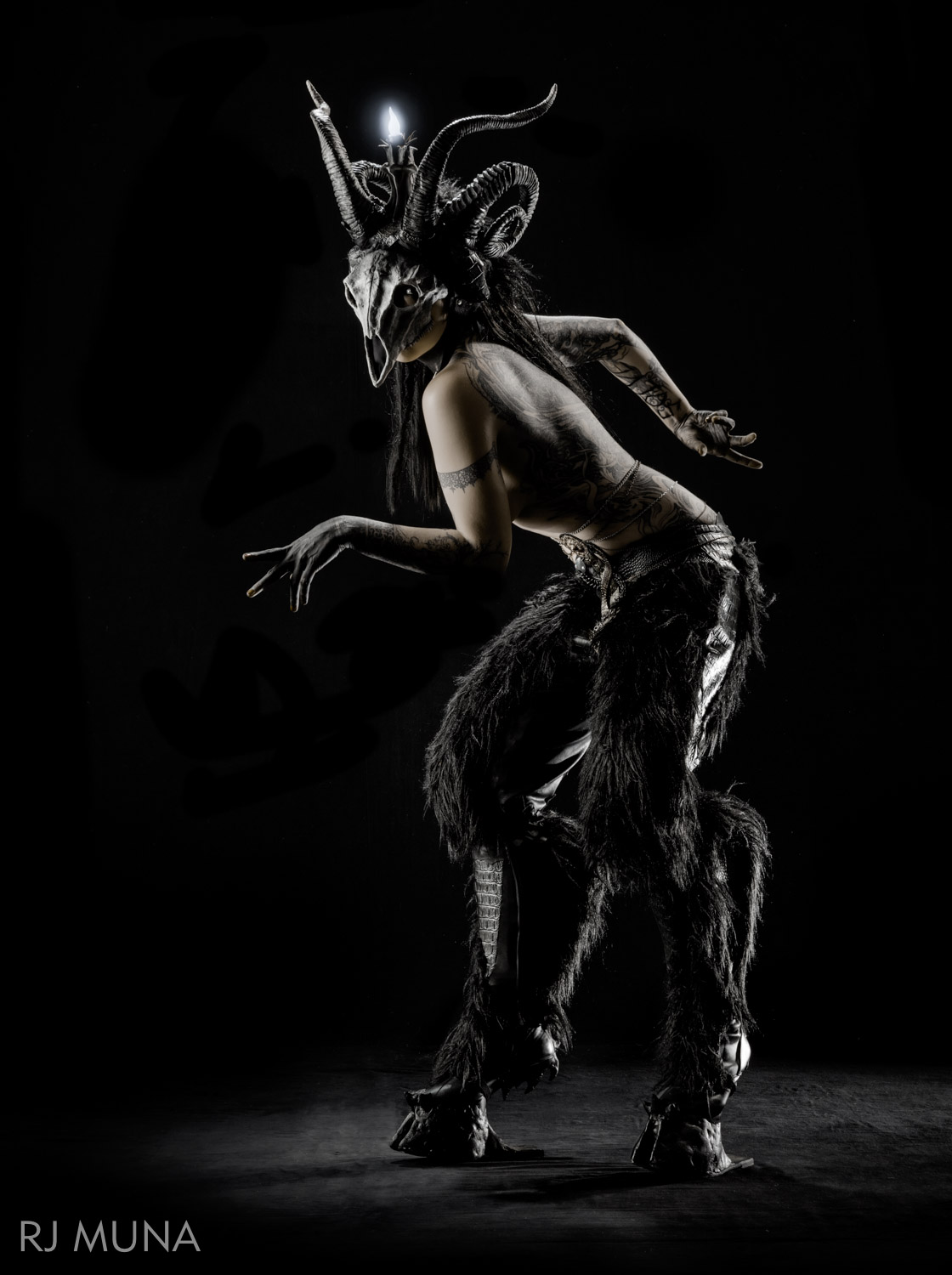
You construct elaborate gothic headdresses that are the stuff of the best nightmares. What’s the psychological function of donning your headdresses and self-created costumes in public or for a performance? Why is it important that you make your costumes yourself? Have you been creating new costume pieces in self-quarantine?
It’s about creating an immersive, complex character or piece. When I have a vision, it’s much easier to create all aspects of it myself. It also gives the piece a more cohesive feel that’s aligned with my personal style as an artist. I also find that creating a character from scratch and being immersed in the process the entire way helps me to truly embody that character.
Sometimes I create the dance first, and then the costuming as needed for the performance. Other times I’ve actually created the character first (I did this with my Baphomet costume; I had painted Baphomet before but I wanted to experience actually becoming it) and then the dance was created later.
Though honestly it simply began because it was more affordable for me to create my own costuming; and it did start out modestly.
So, there was a co-evolution of the costuming and the dance pieces, and like I mentioned above, the different artforms feed each other.
I also create these headdresses and costuming for other people, and that’s simply because I enjoy the chance to employ and practice a large range of skills from sewing to sculpting and painting in one project.
There’s also a unique challenge to wearable art in that it needs to be lightweight, comfortable, durable, and if one is dancing in it there’s a whole other set of challenges to make the costuming and the dancing compatible.
I didn’t plan on making any new costuming (though I have been making regular clothes for myself, which was always a goal to do more of), but I did end up opting to be in a headgear show, so I found my way to making some post-apocalyptic themed works for it.
You travel extensively as a dancer and a public speaker. Did you have any planned showcases that have been postponed or cancelled? Or were there any shows that you were looking forward to attending?
There were no concrete bookings, though I was planning to travel each coast in turn and look for opportunities. I wanted to get back into the vending circuit; I used to make jewelry and vend that along with headdresses and visual art, and was looking to do so again.
That’s been put off indefinitely. I’m hoping to use this time to start making more jewelry in addition to my paintings, with a goal of both building up stock for when I can vend and selling online in the interim.
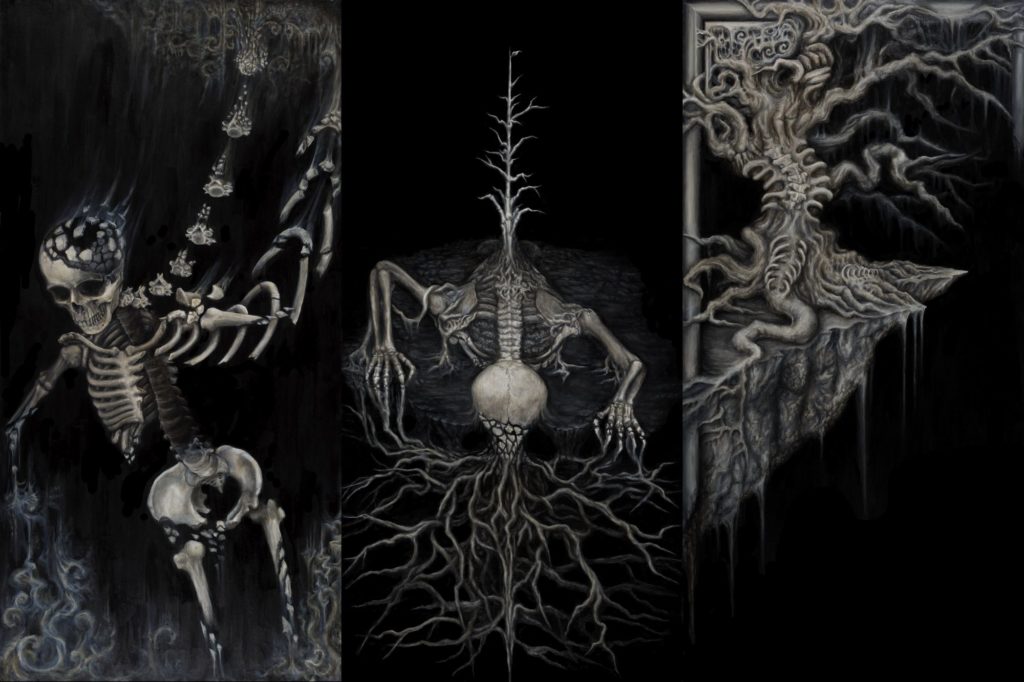
What are your hopes for performances such as dance and live music in the future? Do you think audiences will come back? What would it take for you to feel safe going back out there?
I really hope we reinvent the way artists are regarded and paid.
We are relying on artists more than ever to keep us sane and happy during this time, so I hope that an awareness of their value is maintained even after quarantine is lifted.
I know for musicians, a lot of their money was made from live shows, with things like record sales and merch accounting for less and less of their income. So, for example, the music industry needs to evolve and recognize that now that everyone streams/downloads music, musicians need to be able to make a decent income from that area.
For me as a dancer/performer, I would love to see performers get paid more (or at all) for the shows that we do. I don’t know what it would take to make that happen, but it would begin with our society as a whole valuing the arts more.
From the beginning of lockdown I didn’t think for a moment we’d be having large gatherings anytime soon, so I was a little incredulous that major events were waiting at first to see if they could still happen during the summer.
I’ve maintained that view, and I don’t think I’ll be going out there again until there is a vaccine. Until then, it’s essential errands only with strict social distancing/safety protocols. I am immunocompromised, but even if I weren’t, I would see it as literally life-risking to do otherwise. I’d rather survive this so I can go on to make more art.
Are you working on future performances or is that part of your life completely on hold? Are you dancing in self-quarantine?
I was doing a bit of dancing at first, taking dance classes from live streams. I’ve fallen off from that lately though would like to get back to it.
I think the best thing I could be doing right now is just dancing for the joy of it and for practice. It’s a therapeutic thing, and for so long I was so focused on creating performances I lost a bit of that aspect.
As a dancer, are you able to leverage digital platforms to reach your audience? Have you explored teaching dance online? Is it possible to reach an even wider audience than you might with a live local performance or class? Can digital replace personal and how does it feel different?
I addressed a lot of this above; but I will add here that dance has always felt sort of secondary in terms of how I prioritize my artforms. Maybe it’s because I sunk money into dance, and therefore my other artforms paid for it. Because of that I never felt like I could truly prioritize it.
I was not ever interested in trying to make a living from dance. I used to teach a little bit here and there, but never wanted to become a full-time dance teacher. I even had stopped doing gigs that were just for the sake of money (like, dancing at a private party for example) because I realized my priority was to create powerful dance-as-art and put those pieces out into the world, and anything that wasn’t that wasn’t something I was interested in.
For years I was thinking about those dancers who would just make a quality video of a piece at home or in a studio and put it online and disseminate it that way (they also performed live too, but they embraced video for the strengths in the medium), and I always wanted to try that.
Normally I’d just rely on video taken of a live performance to have a record of a piece, but I like the idea of embracing this new medium for dance performance and figuring out how to make the strengths of digital medium work in my favor.

Has your financial situation been affected by the spread of Covid-19?
It didn’t have an immediate impact. But it’s going to affect my future plans for earning. Online sales were always far inferior to selling in person (via art shows and vending). I am just hoping since everyone is stuck inside, online becomes a better platform for selling art.
There have also been some weird, unforeseen side-effects for me. For example, I am unable to access half my supplies, which I left in storage on the west coast when I went on the road. Among them is my art printer, without which I cannot affordably make prints to sell. I would have been traveling back across the country right around now and gathering up everything else I need.
If I had known all of this would have happened, I would have made room to bring my art printer along. Now I have to figure something else out. (I have done on-demand print sites before but the profit margin is so small it’s barely worth it.)
What can we do to support your work at this time?
Since I’m very wary of taking on commissions, the best thing right now is when people buy the art I’m currently making. I’ll be creating more (and I do have smaller, more affordable pieces planned). Anyone who is interested in becoming a collector can contact me through my website if interested. And of course, sharing my work with other people to widen my reach is always helpful.
In general, buying art from any artist and tipping performers helps too. Remind yourself and your community that art is important, so we can emerge from this revolutionizing the way the world values creators.
Thank you very much Corviid for discussing such personal issues. Are you engaged in any ritual work at this time or inspired by Corviid to consider it? Let us know in the comments below.
To see more of Corviid’s art, visit the website deathvine.com or follow them on Instagram.
Corviid’s illustrations can be found in Effigy: Of Graven Image and Holy Idol by Martin Duffy available through Three Hands Press.
Video of a selection of Corviid’s ritual fusion dance performances can be viewed on Youtube.
Dahlia Jane
Dahlia Jane is a wicked writer living in Los Angeles. She writes about the dark arts scene, goth life and fascinations with the macabre. Dahlia spends her free time obsessing about skulls, devouring true crime and occult books, sewing and making messes.